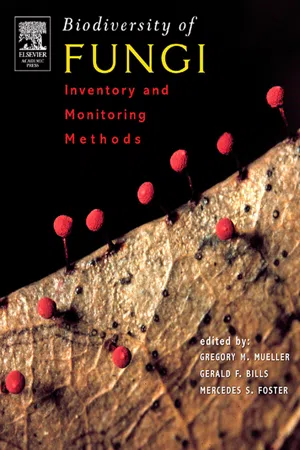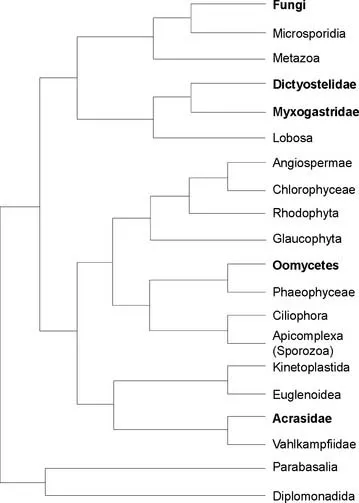
Biodiversity of Fungi
Inventory and Monitoring Methods
- 777 pages
- English
- ePUB (mobile friendly)
- Available on iOS & Android
About this book
Biodiversity of Fungi is essential for anyone collecting and/or monitoring any fungi. Fascinating and beautiful, fungi are vital components of nearly all ecosystems and impact human health and our economy in a myriad of ways. Standardized methods for documenting diversity and distribution have been lacking. A wealth of information, especially regrading sampling protocols, compiled by an international team of fungal biologists, make Biodiversity of Fungi an incredible and fundamental resource for the study of organismal biodiversity.Chapters cover everything from what is a fungus, to maintaining and organizing a permanent study collection with associated databases; from protocols for sampling slime molds to insect associated fungi; from fungi growing on and in animals and plants to mushrooms and truffles. The chapters are arranged both ecologically and by sampling method rather than by taxonomic group for ease of use. The information presented here is intended for everyone interested in fungi, anyone who needs tools to study them in nature including naturalists, land managers, ecologists, mycologists, and even citizen scientists and sophiscated amateurs.- Covers all groups of fungi - from molds to mushrooms, even slime molds- Describes sampling protocols for many groups of fungi- Arranged by sampling method and ecology to coincide with users needs- Beautifully illustrated to document the range of fungi treated and techniques discussed- Natural history data are provided for each group of fungi to enable users to modify suggested protocols to meet their needs
Frequently asked questions
- Essential is ideal for learners and professionals who enjoy exploring a wide range of subjects. Access the Essential Library with 800,000+ trusted titles and best-sellers across business, personal growth, and the humanities. Includes unlimited reading time and Standard Read Aloud voice.
- Complete: Perfect for advanced learners and researchers needing full, unrestricted access. Unlock 1.4M+ books across hundreds of subjects, including academic and specialized titles. The Complete Plan also includes advanced features like Premium Read Aloud and Research Assistant.
Please note we cannot support devices running on iOS 13 and Android 7 or earlier. Learn more about using the app.
Information
| Fungi |
| Chytridiomycota |
| Zygomycota |
| Ascomycota |
| Basidiomycota |
| Straminipila |
| Oomycota |
| Hyphochytriomycota |
| Labyrinthulales |
| Thraustochytriales |
| Slime molds |
| Plasmodiophorales |
| Myxomycota |
| Dictyosteliomycota |
| Acrasiomycota |

A BROAD VIEW OF EUKARYOTES
Table of contents
- Cover image
- Title page
- Table of Contents
- Copyright
- FOREWORD
- PREFACE
- ADDRESSES OF AUTHORS AND CONTRIBUTORS
- INTRODUCTION
- PART I: GENERAL ISSUES
- PART IIA: RECOMMENDED PROTOCOLS FOR SAMPLING PARTICULAR GROUPS OF FUNGI: DIRECT COLLECTING AND ISOLATION PROTOCOLS FOR MACROFUNGI AND MICROFUNGI ON SOIL, WOOD, LEAVES, LICHENS, AND OTHER SUBSTRARA
- PART IIB: RECOMMENDED PROTOCOLS FOR SAMPLING PARTICULAR GROUPS OF FUNGI: ISOLATION PROTOCOLS FOR READILY CULTURABLE MICROFUNGI ASSOCIATED WITH PLANTS AND FUNGI
- PART IIC: RECOMMENDED PROTOCOLS FOR SAMPLING PARTICULAR GROUPS OF FUNGI: COLLECTING AND ISOLATION PROTOCOLS FOR FUNGI ASSOCIATED WITH ANIMALS
- PART IID: RECOMMENDED PROTOCOLS FOR SAMPLING PARTICULAR GROUPS OF FUNGI: COLLECTING AND ISOLATION PROTOCOLS FOR AQUATIC FUNGI AND FOR PROTOCTISTANS FORMERLY TREATED AS FUNGI
- PART III: APPENDICES, GLOSSARY, LITERATURE CITED, AND INDEX
- GLOSSARY
- LITERATURE CITED
- INDEX